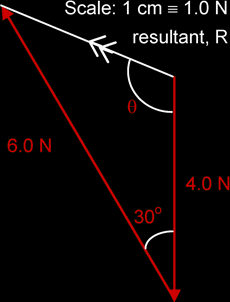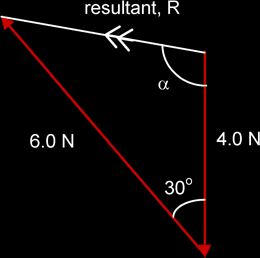Measurement
Base quantities and their units; mass (kg), length (m), time (s), current (A), temperature (K), amount of substance (mol):
| Base Quantities | SI Units | |
|---|---|---|
| Name | Symbol | |
| Length | metre | m |
| Mass | kilogram | kg |
| Time | second | s |
| Amount of substance | mole | mol |
| Temperature | Kelvin | K |
| Current | ampere | A |
| Luminous intensity | candela | cd |
Derived units as products or quotients of the base units:
| Derived | Quantities Equation | Derived Units |
|---|---|---|
| Area (A) | A = L2 | m2 |
| Volume (V) | V = L3 | m3 |
| Density (ρ) | ρ = m / V | kg m-3 |
| Velocity (v) | v = L / t | ms-1 |
| Acceleration (a) | a = Δv / t | ms-1 / s = ms-2 |
| Momentum (p) | p = m x v | (kg)(ms-1) = kg m s-1 |
| Derived Quantities | Equation | Derived Unit | Derived Units | |
|---|---|---|---|---|
| Special Name | Symbol | |||
| Force (F) | F = Δp / t | Newton | N | [(kg m s-1) / s = kg m s-2 |
| Pressure (p) | p = F / A | Pascal | Pa | (kg m s-2) / m2 = kg m-1 s-2 |
| Energy (E) | E = F x d | joule | J | (kg m s-2)(m) = kg m2 s-2 |
| Power (P) | P = E / t | watt | W | (kg m2 s-2) / s = kg m2 s-3 |
| Frequency (f) | f = 1 / t | hertz | Hz | 1 / s = s-1 |
| Charge (Q) | Q = I x t | coulomb | C | A s |
| Potential Difference (V) | V = E / Q | volt | V | (kg m2 s-2) / A s = kg m2 s-3 A-1 |
| Resistance (R) | R = V / I | ohm | Ω | (kg m2 s-3 A-1) / A = kg m2 s-3 A-2 |
Prefixes and their symbols to indicate decimal sub-multiples or multiples of both base and derived units:
| Multiplying Factor | Prefix | Symbol |
|---|---|---|
| 10-12 | pico | p |
| 10-9 | nano | n |
| 10-6 | micro | μ |
| 10-3 | milli | m |
| 10-2 | centi | c |
| 10-1 | decid | d |
103 |
kilo | k |
| 106 | mega | M |
| 109 | giga | G |
| 1012 | tera | T |
Estimates of physical quantities:
When making an estimate, it is only reasonable to give the figure to 1 or at most 2 significant figures since an estimate is not very precise.
| Physical Quantity | Reasonable Estimate |
|---|---|
| Mass of 3 cans (330 ml) of Coke | 1 kg |
| Mass of a medium-sized car | 1000 kg |
| Length of a football field | 100 m |
| Reaction time of a young man | 0.2 s |
- Occasionally, students are asked to estimate the area under a graph. The usual method of counting squares within the enclosed area is used. (eg. Topic 3 (Dynamics), N94P2Q1c)
- Often, when making an estimate, a formula and a simple calculation may be involved.
EXAMPLE 1:
Estimate the average running speed of a typical 17-year-old‟s 2.4-km run.
velocity = distance / time = 2400 / (12.5 x 60) = 3.2 ≈3 ms-1
EXAMPLE 2:
Which estimate is realistic?
| Option | Explanation | ||
|---|---|---|---|
| A | The kinetic energy of a bus travelling on an expressway is 30000J | A bus of mass m travelling on an expressway will travel between 50 to 80 kmh-1, which is 13.8 to 22.2 ms-1. Thus, its KE will be approximately ½ m(182) = 162m. Thus, for its KE to be 30000J: 162m = 30000. Thus, m = 185kg, which is an absurd weight for a bus; ie. This is not a realistic estimate. | |
| B | The power of a domestic light is 300W. | A single light bulb in the house usually runs at about 20W to 60W. Thus, a domestic light is unlikely to run at more than 200W; this estimate is rather high. | |
| C | The temperature of a hot oven is 300 K. | 300K = 27 0C. Not very hot. | |
| D | The volume of air in a car tyre is 0.03 m3. | 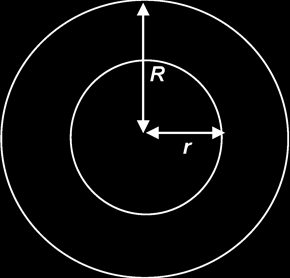 |
Estimating the width of a tyre, t, is 15 cm or 0.15 m, and estimating R to be 40 cm and r to be 30 cm, volume of air in a car tyre is |
Distinction between systematic errors (including zero errors) and random errors and between precision and accuracy:
Random error: is the type of error which causes readings to scatter about the true value.
Systematic error: is the type of error which causes readings to deviate in one direction from the true value.
Precision: refers to the degree of agreement (scatter, spread) of repeated measurements of the same quantity. {NB: regardless of whether or not they are correct.}
Accuracy: refers to the degree of agreement between the result of a measurement and the true value of the quantity.
| → → R Error Higher → → → → → → Less Precise → → → |
||
↓ S Error Less ↓ |
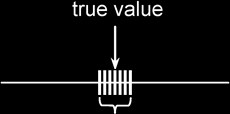 |
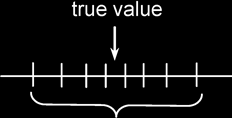 |
 |
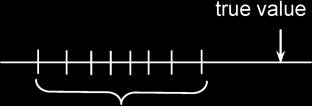 |
|
Assess the uncertainty in a derived quantity by simple addition of actual, fractional or percentage uncertainties (a rigorous statistical treatment is not required).
For a quantity x = (2.0 ± 0.1) mm,
Actual/ Absolute uncertainty, Δ x = ± 0.1 mm
Fractional uncertainty, Δxx = 0.05
Percentage uncertainty, Δxx 100% = 5 %
If p = (2x + y) / 3 or p = (2x - y) / 3 , Δp = (2Δx + Δy) / 3
If r = 2xy3 or r = 2x / y3 , Δr / r = Δx / x + 3Δy / y
Actual error must be recorded to only 1 significant figure, &
The number of decimal places a calculated quantity should have is determined by its actual error.
For eg, suppose g has been initially calculated to be 9.80645 ms-2 & Δg has been initially calculated to be 0.04848 ms-2. The final value of Δg must be recorded as 0.05 ms-2 {1 sf }, and the appropriate recording of g is (9.81 ± 0.05) ms-2.
Distinction between scalar and vector quantities:
| Scalar | Vector | |
|---|---|---|
| Definition | A scalar quantity has a magnitude only. It is completely described by a certain number and a unit. | A vector quantity has both magnitude and direction. It can be described by an arrow whose length represents the magnitude of the vector and the arrow-head represents the direction of the vector. |
| Examples | Distance, speed, mass, time, temperature, work done, kinetic energy, pressure, power, electric charge etc. Common Error: Students tend to associate kinetic energy and pressure with vectors because of the vector components involved. However, such considerations have no bearings on whether the quantity is a vector or scalar. |
Displacement, velocity, moments (or torque), momentum, force, electric field etc. |
Representation of vector as two perpendicular components:
In the diagram below, XY represents a flat kite of weight 4.0 N. At a certain instant, XY is inclined at 30° to the horizontal and the wind exerts a steady force of 6.0 N at right angles to XY so that the kite flies freely.
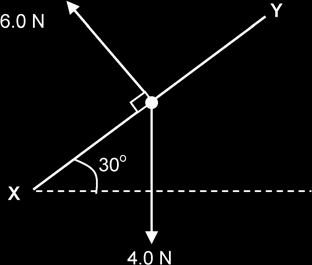
| By accurate scale drawing | By calculations using sine and cosine rules, or Pythagoras‟ theorem |
|---|---|
Draw a scale diagram to find the magnitude and direction of the resultant force acting on the kite.
R = 3.2 N (≡ 3.2 cm) |
Using cosine rule, a2 = b2 + c2 – 2bc cos A Using sine rule: a / sin A = b / sin B |
| Summing Vector Components | |
|---|---|
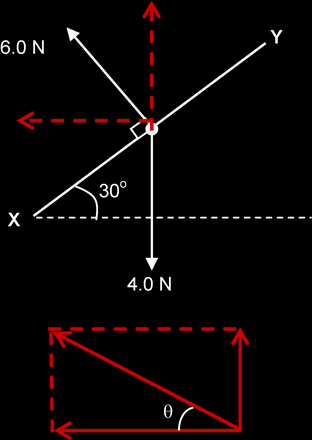 |
Fx = - 6 sin 30° = - 3 N Fy = 6 cos 30° - 4 = 1.2 N R = √(-32 + 1.22) = 3.23 N tan θ = 1.2 / 3 = 22° R is at an angle 112° to the 4 N vector. (90° + 22°) |
